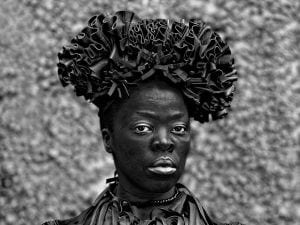Allan Sekula: Fish Story is an immense and ground-breaking research project. Over nine chapters, the image-based piece delves into the profound impact of the globalised shipping trade as well as humankind’s relationship with the sea. It opens at the Walker Art Center in Minneapolis this August, marking the first time the work has been presented in the USA in its entirety since its institutional debut in 1999.
Regarded as one of the most influential photographers and thinkers of his generation, Allan Sekula (1951–2013) blended documentary-style images with essays to create poignant narratives that speak to and critique global social, economic and political structures. From 1989 to 1995, for example, he focused his camera on harbours and major port cities. This resulted in Fish Story, an important conceptual piece of 20th century art that features 105 photographs, slide projections and accompanying texts developed over many years. Sekula was known for drawing on ideas surrounding labour, capitalism and Marxist theory. As Art in America‘s Kaegan Sparks says: “His career was largely dedicated to deconstructing photography’s tendency to sensationalise, fetishise, universalise, and thereby mystify the material conditions of class struggle. How, instead, could an artist document systemic power relations, and even prompt political action through pictures without resorting to contrivance or sentimentalism?”

One example is Panorama. Mid-Atlantic, November 1993, which presents rows of cargo containers surrounded by open sea and dark clouds. The presence of these containers is central, yet what they carry and where remains obscured like the ship beneath them. Elsewhere is the Doomed Fishing Village of Ilsan, September 1993. Boats sit empty on the seafront whilst an indiscernible mix of plastic objects litter the sand, exposing the impact of pollution and lost livelihoods. Another set of images is titled Boy Looking at His Mother. Staten Island Ferry. New York Harbour. February 1990. Gazing out of the frame, the child is photographed just as his attention is diverted from the coin-operated binoculars. A companion piece focuses just on the binoculars and a blurry ship far in the distance. It calls to focus the impact of tourism and critiques how viewing things through any lens can detach us from reality.
Beginning his journey at the Port of San Pedro in his native Los Angeles, Sekula travelled to South Korea, Scotland and Poland. At each location, he photographed workers and communities as well as the built and natural environments that support the global shipping trade. Weeks, at times months, were spent in these coastal towns and cities, living and working alongside tradespeople to unearth stories and experiences that were little discussed and, therefore, often invisible. He was keenly aware that sharing these perspectives was an act of profound political importance. Whilst discussing how sailors and dockers are in the prime position to see government policies in effect – such as the transfer of food, goods and weapons – Sekula writes in the Fish Story photobook: “We know now that actors can make politics. The next question to be asked is this: How do governments – and the actors who speak for governments – move cargo? How do they do it without stories being told by those who do the work? Could the desire for the fully automated movement of goods also be a desire for silence, for the tyranny of a single anecdote?”

Fish Story remains relevant today. Each chapter relates to a different aspect of maritime commerce, emphasising class and labour dynamics within the profit-focused structures of globalised trade. Today, the sea continues to be a backdrop for issues facing humanity, such as the environmental crisis and refugees who make dangerous journeys every day. The Guardian reports that the shipping industry accounts for 3% of global greenhouse gas emissions, whilst rising sea levels threaten entire countries, most of which contribute the least of these emissions: “Within decades, archipelagos could lose outlying atolls that define national borders. A century from now – if not sooner – entire states could become uninhabitable, raising doubts about what will happen to their citizens, governments and resources.“
Contemporary artists continue to confront global problems connected to the sea. Olaf Otto Becker (b. 1959), for instance, records Greenland’s melting ice sheets within Ilulissat – Sculpture of Change, his lens an “eyewitness” to landscapes forever altered by the climate crisis. Below sea level, Mandy Barker (b. 1964) highlights the plastic debris polluting the oceans and suffocating sea-life. Alejandro Durán also brings this reality into touching distance. Washed Up (2010) presents bright blue rubbish bursting out from an ocean photograph hung on the wall, spreading all over the floor of the Weltkulturen Museum, Germany. This piece will be part of Healing. Life in Balance, an exhibition that unifies international perspectives from the arts, sciences and medicine to find strategies for resolving crises and building a better world.

William Hernández Luege, Curatorial Assistant of Visual Arts, refers to Fish Story as a “seminal work” that “remains as vital as ever in its encapsulation of the effects of globalised trade and shipping on individuals, communities and the natural world, which have only become heightened in recent years. The piece feels incredibly prescient and poetic within our contemporary contexts.” This exhibition celebrates an evocative reflection on capitalism, labour, international politics, climate change, and our connections to water.
Walker Art Centre: Allan Sekula: Fish Story | 24 August – 21 January 2024
Words: Diana Bestwish Tetteh
Image Credits:
- Allan Sekula, Chapter Sux: “True Cross” from Fish Story (#87) 1988-1995. Walker Art Center. Courtesy the artist.
- Allan Sekula, Chapter Three: “Middle Passage” from Fish Story (#34) 1988-1995. Walker Art Center. Courtesy the artist.
- Allan Sekula, Chapter Seven: “Dictatorship of the Seven Seas” from Fish Story (#104) 1988-1995. Walker Art Center. Courtesy the artist.
- Allan Sekula, Chapter One: “Fish Story” from Fish Story (#08) 1988-1995. Walker Art Center. Courtesy the artist.




